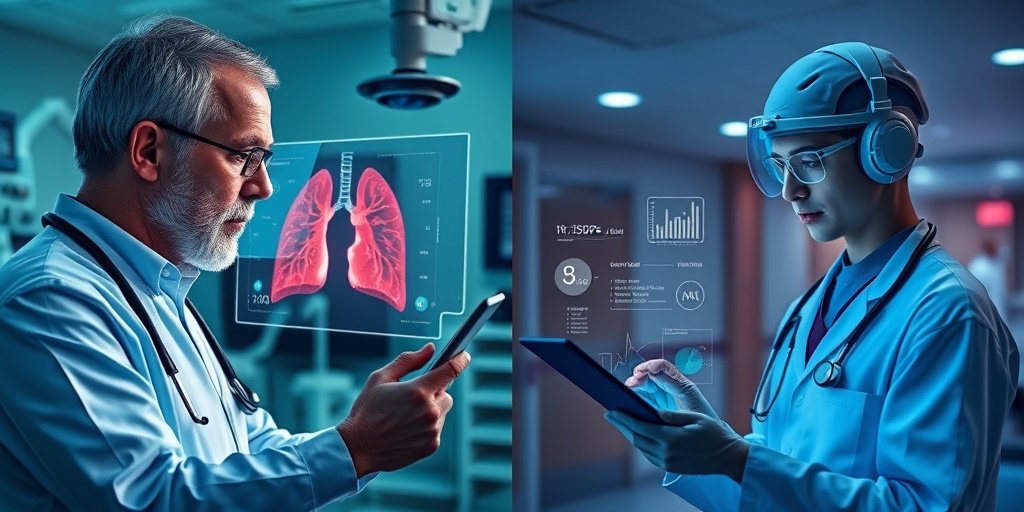⚡ Quick Summary
This study evaluated the effectiveness of the Iriscope, a 1.3 mm video endoscopic probe, in diagnosing peripheral pulmonary nodules (PPNs) by comparing the performance of experienced physicians and a deep learning (DL) model. The results indicated that senior physicians achieved a balanced accuracy of 85.4%, while the DL model reached 71.5%, highlighting the potential of Iriscope in enhancing diagnostic capabilities, especially for less experienced operators.
🔍 Key Details
- 📊 Patient cohort: 61 patients with PPNs < 20 mm
- 🧩 Diagnostic categories: Tumoral (malignant) vs. non-tumoral
- ⚙️ Technology used: Iriscope video endoscopic probe and DL model
- 🏆 Performance metrics: Balanced accuracy, sensitivity, specificity, F1 score
🔑 Key Takeaways
- 🔬 Iriscope allows direct visualization of small PPNs, enhancing diagnostic accuracy.
- 👩⚕️ Senior physicians outperformed junior physicians in identifying malignancies.
- 📈 Balanced accuracy: Senior physicians: 85.4%, Junior physicians: 66.7%, DL model: 71.5%.
- 💡 Deep learning can assist less experienced physicians in diagnosing malignancy.
- 🌟 The study included a diverse cohort of patients with varying PPN sizes.
- 🧠 AI integration in medical diagnostics is showing promising results.
- 🏥 Potential applications of Iriscope could significantly improve lung cancer management.

📚 Background
The diagnosis of peripheral pulmonary nodules (PPNs) poses a significant challenge in clinical practice, particularly when these nodules are small and difficult to assess. Traditional methods often rely on imaging techniques that may not provide definitive results. The introduction of advanced technologies, such as the Iriscope, aims to bridge this gap by offering direct visualization of PPNs, potentially leading to more accurate diagnoses and better patient outcomes.
🗒️ Study
This study involved patients undergoing bronchoscopy with r-EBUS and the Iriscope for PPNs measuring less than 20 mm. Both senior and junior physicians independently interpreted video sequences from the Iriscope, classifying them as tumoral or non-tumoral without knowledge of the final diagnosis. Additionally, a deep learning model was trained on Iriscope images to compare its performance against human interpretation.
📈 Results
The study included a total of 61 patients, with a median PPN size of 15 mm. The final diagnoses revealed 37 cases of cancer and 24 benign lesions. Senior physicians demonstrated a significantly higher diagnostic accuracy compared to their junior counterparts, achieving a balanced accuracy of 85.4%. The deep learning model, while outperforming junior physicians with a balanced accuracy of 71.5%, did not surpass the performance of senior physicians.
🌍 Impact and Implications
The findings from this study underscore the potential of the Iriscope as a valuable tool in the management of PPNs, particularly for experienced operators. The integration of deep learning technology could further enhance the diagnostic capabilities of less experienced physicians, ultimately leading to improved patient care and outcomes in lung cancer management. As we continue to explore the intersection of technology and medicine, the implications for early cancer detection and treatment are profound.
🔮 Conclusion
This study highlights the promising role of the Iriscope in diagnosing peripheral lung cancer, showcasing the advantages of combining human expertise with artificial intelligence. As we advance in our understanding and application of these technologies, we can expect significant improvements in diagnostic accuracy and patient management. Continued research and development in this area are essential for harnessing the full potential of AI in healthcare.
💬 Your comments
What are your thoughts on the use of advanced technologies like Iriscope in lung cancer diagnosis? We would love to hear your insights! 💬 Share your comments below or connect with us on social media:
Human and Deep Learning Predictions of Peripheral Lung Cancer Using a 1.3 mm Video Endoscopic Probe.
Abstract
BACKGROUND AND OBJECTIVE: Iriscope, a 1.3 mm video endoscopic probe introduced through an r-EBUS catheter, allows for the direct visualisation of small peripheral pulmonary nodules (PPNs). This study assessed the ability of physicians with different levels of experience in bronchoscopy, and the ability of artificial intelligence (AI) to predict the malignant nature of small PPNs during Iriscope peripheral endoscopy.
METHODS: Patients undergoing bronchoscopy with r-EBUS and Iriscope for peripheral PPNs < 20 mm with a definite diagnosis were analysed. Senior and Junior physicians independently interpreted video-recorded Iriscope sequences, classifying them as tumoral (malignant) or non-tumoral, blind to the final diagnosis. A deep learning (DL) model was also trained on Iriscope images and tested on a different set of patients for comparison with human interpretation. Diagnostic accuracy, sensitivity, specificity, and F1 score were calculated.
RESULTS: Sixty-one patients with small PPNs (median size 15 mm, IQR: 11-20 mm) were included. The technique allowed for the direct visualisation of the lesions in all cases. The final diagnosis was cancer for 37 cases and a benign lesion in 24 cases. Senior physicians outperformed junior physicians in recognising tumoral Iriscope images, with a balanced accuracy of 85.4% versus 66.7%, respectively, when compared with the final diagnosis. The DL model outperformed junior physicians with a balanced accuracy of 71.5% but was not superior to senior physicians.
CONCLUSION: Iriscope could be a valuable tool in PPNs management, especially for experienced operators. Applied to Iriscope images, DL could enhance overall performance of less experienced physicians in diagnosing malignancy.
Author: [‘Amante E’, ‘Ghyselinck R’, ‘Thiberville L’, ‘Trisolini R’, ‘Guisier F’, ‘Delchevalerie V’, ‘Dumas B’, ‘Frénay B’, ‘Duparc I’, ‘Mazellier N’, ‘Farhi C’, ‘Jubert C’, ‘Salaün M’, ‘Lachkar S’]
Journal: Respirology
Citation: Amante E, et al. Human and Deep Learning Predictions of Peripheral Lung Cancer Using a 1.3 mm Video Endoscopic Probe. Human and Deep Learning Predictions of Peripheral Lung Cancer Using a 1.3 mm Video Endoscopic Probe. 2025; (unknown volume):(unknown pages). doi: 10.1111/resp.70057